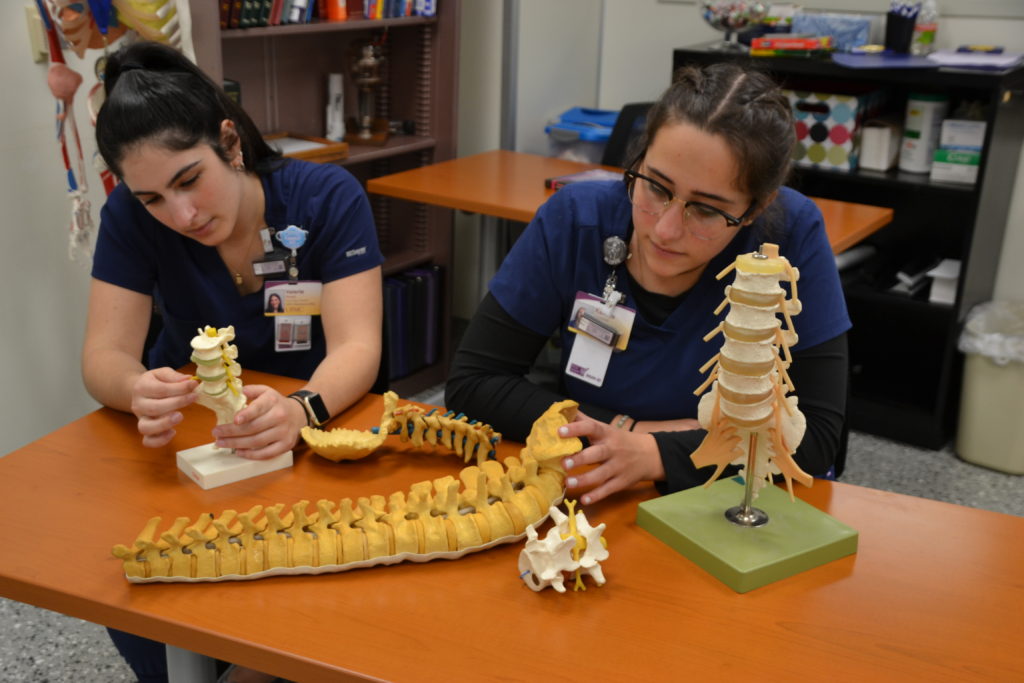The aim of the curriculum is to provide a correlated sequence of systematic instruction and clinical experience in the Science of Radiologic Technology. The program is based on two years of study with a maximum of forty (40) hours of combined clinical and academic instruction per week.
For a student to progress through the program and graduate he / she must maintain a 75% average or above in each individual course as well as an overall grade. Evaluation will consist of, written and practical examinations and observation.

Program Outline - Year 1
Trimester # 1
- RT 101 – Intro to Radiologic Technology
- RT 102 – Medical Terminology 1
- RT 103 – Patient Care and Pharmacology 1
- RT 104 – Anatomy & Physiology 1
- RT 105 – Procedures 1
- RT 106 – Procedures Lab 1
- RT 107 – Physics & Equipment 1
- RT 109 – Image Critique 1
- RT 112 – Radiation Protection and Biology 1
- RT 110 -Clinical Experience 1
Trimester # 2
- RT 203 – Patient Care and Pharmacology 2
- RT 204 – Anatomy & Physiology 2
- RT 205 – Procedures 2
- RT 206 – Procedures Lab 2
- RT 207 – Physics & Equipment 2
- RT 208 – Exposure & Processing 1
- RT 209 – Image Critique 1 continued
- RT 210 – Clinical Experience 2
- RT 212 – Radiation Protection & Biology 2
Trimester # 3
- RT 310 – Clinical 3
Program Outline - Year 2
Trimester # 4
- RT 408 – Exposure & Processing 2
- RT 404 – Anatomy & Physiology 3
- RT 405 – Procedures 3
- RT 406 – Procedures Lab 3
- RT 411 – Pathology
- RT 410 – Clinical Experience 4
Trimester # 5
- RT 512 – Senior Review
- RT 510 – Clinical Experience 5
- RT 409 – Image Critique 2
Trimester # 6
- RT 610 – Clinical Experience 6
Trimesters run tentatively
1 = 3rd Week in August – 3rd Week in December
2 = 1st Week in January – 4th Week in May
3 = 1st Week in June – 2nd Week in September
4 = 3rd Week in September – 3rd Week in December
5 = 1st Week in January – 4th Week in April
6 = 1st Week in May – 2nd Week in June
Course Descriptions - Year 1
The students are given an overview of the history of radiology. The policies of the radiology program are reviewed and discussed. An understanding of the healthcare team is established. The students are made aware of the organizational structure of the radiology department and the hospital. The students are taught about accreditation, certification, licensing, professional organizations, and career advancements in radiology. The students are introduced to medical ethics and medico-legal principles.
The art of effective communication and body language is discussed. The importance of medical asepsis in the radiology department is realized. The students learn how to admit a patient to the radiology department and how to properly move and transfer patients. Vital signs and oxygen administration are learned and practiced. The students are taught to care for patients with various problems (e.g. skull or spinal injuries, pediatric or geriatric patients, shock, etc.). Proper methods of the administration of enemas and caring for patients with various types of tubes are discussed. Surgical aseptic technique, proper skin preparation, and venipuncture is learned. The student is taught how to assist with drug and contrast media administration. Various contrast complications and anaphylactic reactions are discussed. Transmission of microorganisms and isolation techniques are learned.
The students will learn the origins, word building, terminology related to the various systems of the body and medical abbreviations and symbols that are routinely used in radiography.
Course Descriptions - Year 2
To acquaint the students with basic medical terminology used to describe various pathologic conditions occurring in the human body and introduce the students to some specialized imaging techniques. The students will be able to classify more common diseases in terms of their penetrability by x-rays and become familiar with the changes in technical factors required for obtaining optimal quality radiographs on patients with various underlying pathologic conditions.
The students will learn various pathologic conditions of the respiratory system, skeletal system, gastrointestinal system, urinary system, reproductive system, nervous system, endocrine system, hemopoietic system, and cardiovasular system.
Graduation Requirements
A student who successfully completes the following requirements of the school will (1) qualify for graduation and (2) be permitted to sit for the American Registry of Radiologic Technologist Examination for national certification and state licensing.
- Complete all academic courses and the clinical competency program according to the established criteria. A student with incomplete records in either of these areas shall not be granted a certificate and will not be authorized by the Educational Director as meeting the educational requirements for certification by the American Registry of Radiologic Technologists.
- Complete two (2) years of training in Medical Radiography with a minimum average of “75%” in all subjects. Failure on the student’s part to fully complete the program prior to the graduation date will require the student to remain after graduation for completion.
- Demonstrate competence in all routine procedures and techniques.
- Meet all financial obligations to the school.
- Be of good moral character and able to communicate effectively with patients and personnel in an ethical manner.
- Be an asset to the profession in accordance with faculty and administration evaluations.
